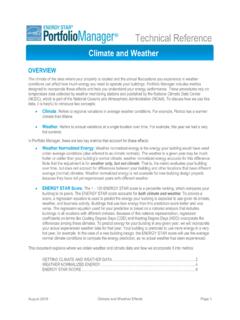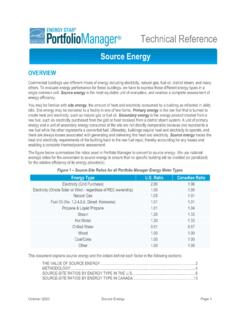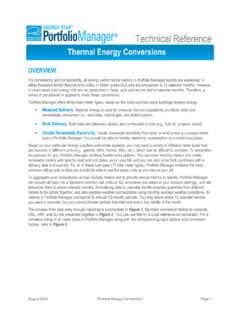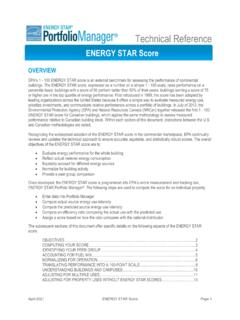Transcription of Greenhouse Gas Inventory and Tracking in Portfolio Manager
1 Technical Reference Greenhouse Gas Emissions OVERVIEW. The energy used in commercial buildings results in significant emissions of Greenhouse gases (GHGs) linked to global climate change, making buildings an important part of your GHG Inventory . In order to help you assess the emissions footprint associated with your energy consumption, Portfolio Manager incorporates a number of metrics to quantify these emissions. Total Emissions. Total Emissions is the primary metric, quantifying the majority of GHGs associated with commercial buildings. It can be broken down into component metrics, also available in Portfolio Manager : Direct Emissions. Emissions from fuel that is directly burned at your building, for example natural gas that may be combusted to heat your property. Indirect Emissions. Emissions associated with energy purchased from a utility, for example emissions associated with the generation of electricity or district steam.
2 Biomass Emissions. Biomass emissions are an additional element in your Inventory . These are emissions from biogenic fuels that are burned onsite, such as wood. Though combustion occurs on site, the emissions from burning biomass are accounted for separately from direct fossil fuel emissions because they may or may not reduce carbon emissions, depending on the type and source of the biomass resources. Emissions are calculated by multiplying your site energy values by emissions factors. These factors incorporate the emissions of carbon dioxide, methane, and nitrous oxide, to provide a single carbon dioxide equivalent number. Portfolio Manager uses custom factors for the and Canada, which are further regionalized to account for differences within each country. For properties in other countries, the factors are applied. Green power (electricity generated from environmentally preferable renewable resources, such as solar, wind, geothermal, low-impact biomass, and low-impact hydro resources) can have an important effect on your emissions Inventory .
3 Green power may be obtained from either onsite sources or offsite sources. We include a variety of metrics to help you understand the emissions benefit. Offsite Green Power. When you purchase offsite green power, you are making a purchase of electricity from the grid bundled with environmental benefits defined by Renewable Energy Certificates (RECs). We show the emissions associated with a conventional grid purchase, and the avoided emissions quantified in the REC. Onsite Green Power. When you have an onsite renewable system, the implications for emissions depend on whether you own the RECs. If you do, then onsite green power is counted as zero emissions in your GHG Inventory , and you can also track the total avoided emissions associated with the system. If you do not own the RECs, you cannot claim an environmental benefit. This technical reference is divided into the following sections: THE VALUE OF A GHG Inventory .
4 2. CALCULATING DIRECT EMISSIONS .. 3. CALCULATING INDIRECT EMISSIONS .. 4. CALCULATING BIOMASS EMISSIONS .. 5. UNDERSTANDING AVOIDED EMISSIONS FROM GREEN POWER .. 5. REFERENCE GHG EMISSIONS FACTORS .. 6. August 2021 Greenhouse Gas Emissions 1.. Technical Reference THE VALUE OF A GHG Inventory . Carbon dioxide (CO2), methane (CH4), and nitrous oxide (N2O) are the principal Greenhouse gases emitted to the atmosphere from the burning of fossil and biomass fuels used in commercial buildings. The energy used by commercial buildings in the United States accounts for more than 16% of the nation's Greenhouse gas (GHG). emissions. 1 In Canada, the energy used by commercial, institutional, and residential buildings accounts for 17% of Canada's Greenhouse gas (GHG) emissions. 2 This makes commercial buildings an important target for organizations interested in pursuing energy and GHG management and reduction programs.
5 Tracking and managing your GHG. footprint can help improve your bottom line, while also helping to fight global climate change. Portfolio Manager can help you Inventory , track, and communicate the GHG emissions associated with the energy used by buildings in your Portfolio . This includes a variety of metrics and graphs to demonstrate GHG emissions performance. An effective GHG reduction strategy may incorporate not only energy efficiency in your buildings, but also the purchase of green power to ensure that the energy you use comes from sources with a reduced GHG. footprint. Therefore, Portfolio Manager includes several metrics to help you understand the environmental benefits of both onsite and offsite green power. The methodology for calculating GHG emissions in Portfolio Manager is based on the Greenhouse Gas Protocol Corporate Accounting and Reporting Standard developed by the World Resources Institute (WRI) and World Business Council for Sustainable Development.
6 3 This protocol was developed as the accounting framework to provide a relevant, complete, consistent and transparent account of an organization's GHG emissions. As the global standard, it serves as the basis for the accounting, Inventory and reporting guidance provided by the Environmental Protection Agency's (EPA) Center for Corporate Climate Leadership, as well as state and non-governmental organization registry, reporting, and recognition programs. The specific calculation details depend on the type of emissions, as detailed in the following sections. Please note that Portfolio Manager does not account for energy consumed for onsite vehicle use, industrial or manufacturing processes, or fugitive refrigerant emissions resulting from a building's use of refrigeration or air conditioning equipment. These are important contributors to an organization's GHG footprint, but outside of the scope of Portfolio Manager .
7 WRI Protocol Updates and Scope 2 Emissions In January 2015 the World Resources Institute amended their Green House Gas Protocol Corporate Accounting and Reporting Standard to update requirements and best practices for accounting and reporting of indirect (or scope 2). emissions. 4 Among these changes, the amendments now require indirect emissions to be calculated and reported in two ways: a location-based method relying on grid-average emissions factors, and a market-based method using energy supplier-specific emissions factors. The accounting and reporting of green power purchases on scope 2. emissions has also been changed. The current approach in Portfolio Manager is most closely aligned with the 1 U. S. Environmental Protection Agency, Inventory of Greenhouse Gas Emissions and Sinks: 1990-2017. Table 2-12: Greenhouse Gas Emissions by Economic Sector and Gas with Electricity Related Emissions Distributed (MMT CO2 Eq.)
8 And Percent of Total in 2017. 2 Specific Mitigation Opportunities Working Group: Final Report. Section , Built Environment. Published in 2016. d6db7db5cbc0 3 World Resources Institute and the World Business Council for Sustainable Development, The Greenhouse Gas Protocol; A Corporate Accounting and Reporting Standard. Revised Edition. 4 World Resources Institute and the World Business Council for Sustainable Development, The Greenhouse Gas Protocol; GHG Protocol Scope 2 Guidance, an amendment to the GHG Protocol Corporate Standard. August 2021 Greenhouse Gas Emissions 2. Technical Reference updated location-based method. EPA is assessing changes to more fully align with the location-based method and to facilitate the market-based method in the future. Tracking Emissions Over Time Calculating building energy use and environmental performance in Portfolio Manager is accomplished by applying one set of thermal and emissions fuel factors to a building's historical energy consumption.
9 These factors (detailed in the last subsequent sections) are updated annually using the most current available datasets. By applying updated factors to all previous energy consumption periods, Portfolio Manager recalculates your previous years' emissions, effectively re-baselining emissions for your buildings. Portfolio Manager users have the ability to print out reports annually to document their historical emissions metrics. Documenting emissions using the factors applied at the time the Inventory is created is consistent with the EPA's Center for Corporate Climate Leadership guidance for baselining, calculating, and reporting GHG emissions inventories over time. Organizations may use the Center's Summary Form for Inventory Reporting and Goal Tracking to summarize annual GHG emissions reports from Portfolio Manager , and track emissions over time against a GHG reduction goal. CALCULATING DIRECT EMISSIONS.
10 To calculate direct GHG emissions, Portfolio Manager uses what is called a default fuel analysis approach. This approach requires that you know only the type and quantity of fuel. It eliminates the need for you to obtain fuel specific characteristics from your energy suppliers, as it assumes fuel-specific factors for heating value, carbon content, carbon to CO2 ratio (12:44), and carbon oxidation factor (100%) for each fuel. Note that this methodology accounts for the emissions that occur at your building only emissions that may have occurred during extracting, processing, or delivering these fuels is the responsibility of the fuel supplier and does not fall within your Inventory . While a default fuel analysis approach provides a straightforward estimation of direct CO2 emissions, estimating direct emissions of CH4, and N2O is much more complicated. Unlike CO2 emissions, CH4, and N2O emissions depend not only upon fuel characteristics, but also on combustion technology (size, vintage, maintenance, and operation), combustion characteristics, usage of pollution control equipment, and ambient environmental conditions.





